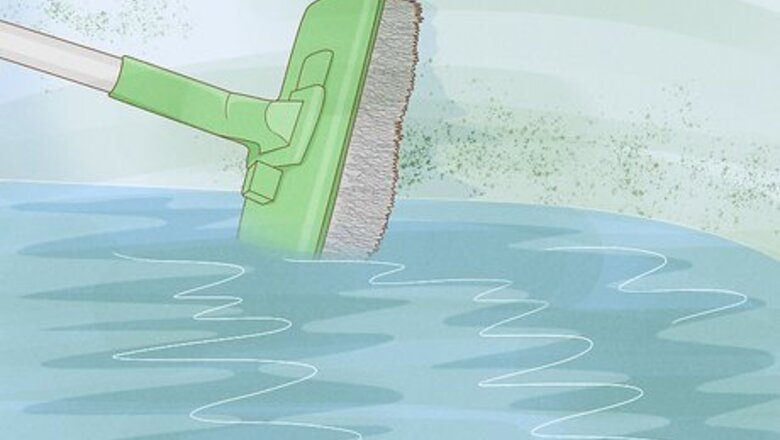
views
- Scrub your pool walls with a pool brush to loosen algae stuck on the surface. Reduce your pool’s pH with sodium bisulfate until the levels are between 7.2–7.6.
- Apply 0.7 oz (20 g) of chlorine shock treatment for every 500 US gal (1,900 L) of water in your pool. Run your filter for 8 hours to circulate the treatment.
- Use a pool vacuum and clean out your filter to get rid of the dead algae leftover in your pool.
Chlorine Shock Treatment
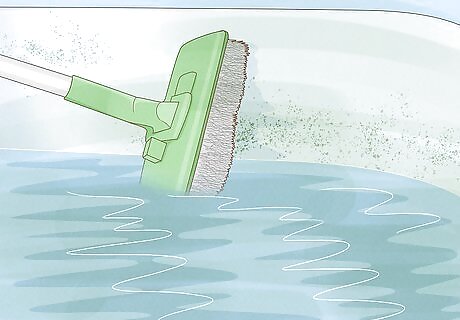
Scrub the walls and floor of the swimming pool with a pool brush. Steel brushes work best on concrete pools while nylon brushes work better for vinyl pools. Brush vigorously to remove and loosen as much of the algae as possible. Pay special attention to the steps, behind ladders, and other nooks and crannies where algae tends to gather. Brushing the algae off your pool surfaces helps the shock treatment work faster since the algae is floating in the water rather than stuck on the walls or floor.

Reduce the pool pH to a level between 7.2–7.6. Fill a pool test kit with a sample of your pool water, and add about 5 drops of the pH indicator solution included in the kit. If the pH is above 7.6, which is common during an algae bloom, add a pH reducer such as sodium bisulfate to your pool according to label instructions. Wait at least 2–3 hours before testing the pool water again. Stick with test kits that use tablets or droppers since they’re more accurate than paper test strips. Algae rarely grows in lower pH, but if your pool is below a pH of 7.2, add about 5 ounces (140 g) of soda ash for every 10,000 gallons (38,000 L) in your pool. If pH levels are back to normal but total alkalinity is above 120 parts per million (ppm), follow the instructions on the pH reducer label to bring the total alkalinity down between 80–120 ppm.

Add chlorine shock treatment to your pool water. Use about 0.7 ounces (20 g) of shock treatment for every 500 gallons (1,900 L) of water in your pool. Wait until the evening after the sun sets to shock your pool so the UV rays don’t break down the chlorine. Dissolve the shock treatment in a bucket full of water, and pour it as close as possible to the algae on the sides and bottom of your pool. Keep your filter running for at least 8 hours after adding the shock treatment so it continues to cycle through the water. Wear gloves, eye protection, and clothing that covers your skin whenever you handle chlorine products. If the algae has a mustard-yellow or dark black appearance instead of green, then add double or triple the shock treatment to your pool water to make it more effective. Avoid swimming in your pool for 2–3 days after applying a shock treatment since the high chlorine levels can irritate your skin and eyes.
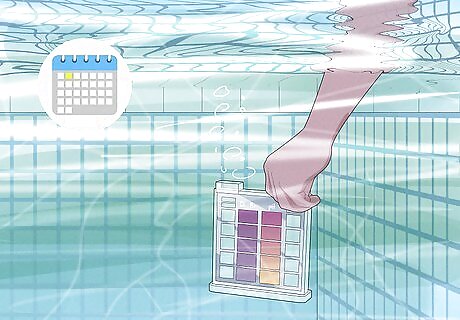
Test the pool’s chlorine and pH levels again the next day. Check on your pool the following morning to see if there’s dead algae, which will look brown or gray floating in the water or settled on the pool floor. Use another pool test kit to check the new chlorine and pH levels of the water, and make adjustments depending on your measurements. If your chlorine levels are between 2–5 ppm but the algae is still there, then keep maintaining the same level for the next 2–3 days to kill off the rest of the algae. If chlorine levels have gone up slightly but are still below 2 ppm, add another dose of the shock treatment once it’s dark outside. If you don’t notice a change in the chlorine levels, your pool may have too much cyanuric acid. Continue adding shock treatment to your pool each day until you see an increase in chlorine. Alternatively, drain your pool partially to make the chlorine more concentrated.
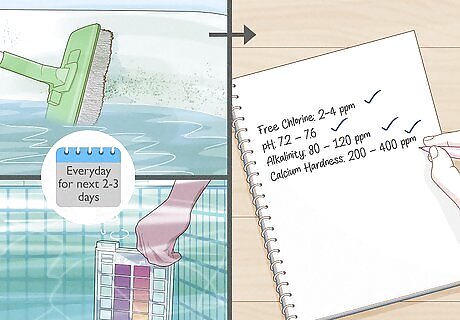
Brush and test your pool every day for the next 2–3 days. Use your pool brush to vigorously scrub the algae on the walls and floor that loosened up from the shock treatment. Over the next 2–3 days, the chlorine levels will continue to kill all the algae in your pool water, so test daily to maintain your swimming pool at the proper levels. Keep your pool at the following levels so the shock treatment continues to destroy the rest of the algae: Free Chlorine: 2-4 ppm pH: 7.2 – 7.6 Alkalinity: 80 – 120 ppm Calcium Hardness: 200 – 400 ppm
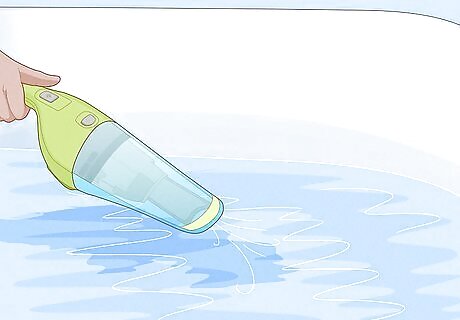
Vacuum your pool to remove the dead algae. Once the green color disappears from your pool, hook up a pool vacuum to suck up all the dead algae. Run the vacuum across the bottom and along the walls of your pool in long sweeping strokes to suck up all the loose algae. Move the vacuum slowly across your pool so it doesn’t kick debris back up into the water. If you move the vacuum too quickly, wait a minute or two for the algae to settle back on the bottom again.
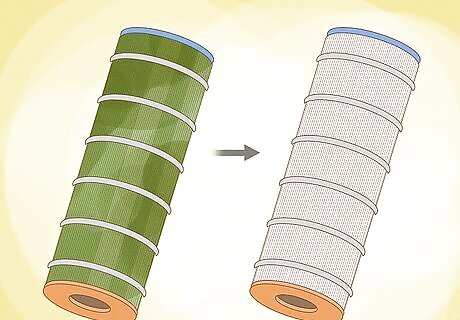
Clean dead algae out of your pool filter. Check your pool filter’s pressure gauge, and clean it if the levels are 10 PSI above the standard pressure (usually between 5–20 PSI). If you have a diatomaceous earth or sand filter, set the valve to backwash to flush out all the algae inside. If you have a cartridge filter, remove it and clean the cartridge with a jet attachment on your hose. If you do not clean the filter thoroughly, then the dead algae may block the filter and prevent your pool water from circulating. Monitor your pool filter system closely during the entire shock treatment since the dead algae may quickly build up inside the filter and need to be cleaned out more frequently.
Alternative Algae Treatments
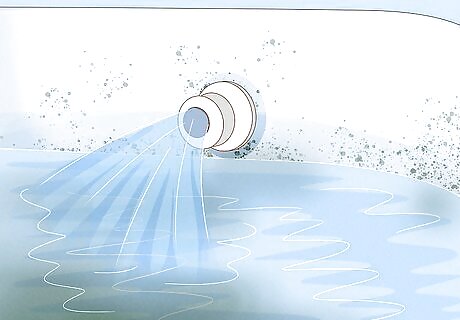
Improve your pool’s circulation to handle small spots of algae. If small clumps of algae form but don’t spread to the rest of the pool, there may be areas of stagnant water. Check that the water jets inside your pool are active and circulating water through your pool. Point the jets downward so the water at the bottom of your pool moves through the filter system to kill any algae growing there. Check the skimmer basket on your pool’s filter as well since clogs could prevent water from moving through your system.
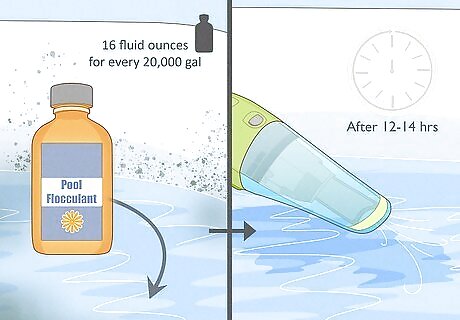
Use pool flocculant to collect loose algae before vacuuming. A flocculant or “floc” clumps the algae together so it’s easier to suck up and remove from your pool. Shake the bottle of flocculent and follow the manufacturer’s mixing instructions to add the required amount for the size of your pool, usually around 16 fluid ounces (470 ml) for every 20,000 gallons (76,000 L) of pool water. Pour the flocculent directly into your pool’s skimmer and run your filter for 4 hours. Then, let the water sit for 12–14 hours before vacuuming the bottom of your pool. Avoid using pool floc if you have a cartridge filter since it could cause a severe clog.
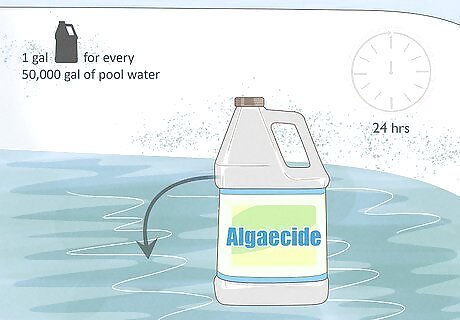
Treat the pool with algaecide if it has cloudy water. Algaecide contains chemicals that kill and destroy algae blooms in your pool. Follow the instructions on the algaecide package to find out how much to add to your pool, which is usually around 1 gallon (3.8 L) for every 50,000 gallons (190,000 L) of pool water. Add the algaecide to your pool, and let it circulate for 24 hours. After that, simply vacuum up all the dead algae on the bottom of your pool. If there’s still algae growing in your pool water, then repeat the treatment the next day. After adding algaecide, wait at least 24 hours before adding other chemicals or treatments to your pool.
Preventing Algae
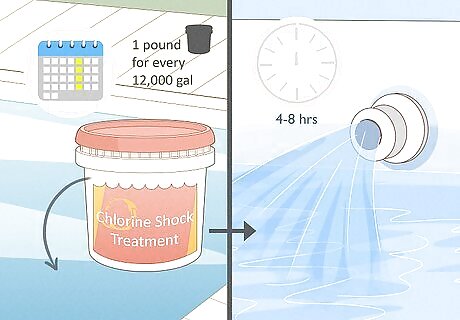
Shock your pool once a week. Find an evening each week to apply 1 pound (450 g) of shock treatment for every 12,000 gallons (45,000 L) of pool water. Spread the shock treatment in the deepest section of your pool and run the filter for 4–8 hours so the treatment circulates through your entire pool and kills any algae before it has the chance to bloom. If you notice any shock treatment granules at the bottom of your pool after 15 minutes, use a pool brush to spread them around and help them dissolve. After a weekly shock treatment, wait at least 15 minutes before going back in your pool when the chlorine levels are between 1–4 ppm.
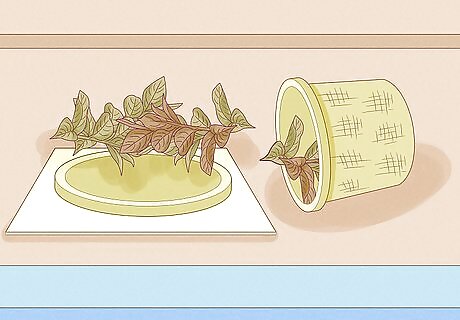
Clean your pool weekly. Make time to check and empty the skimmer basket on your filter so it doesn’t get clogged and prevent water from circulating in your pool. Use your pool brush to scrub the walls and floor of your pool as well to ensure that no algae sticks to the surfaces. Then, make sure you vacuum your pool floor weekly to keep your pool water clean and clear. If you have a pool party or if there’s a heavy storm, then clean your pool right away before algae has a chance to form.
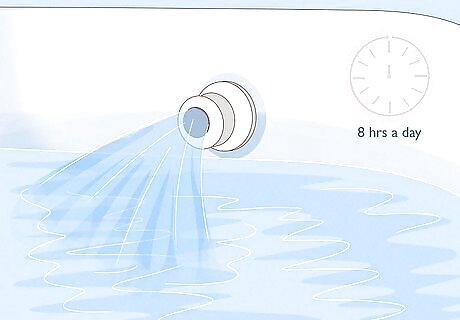
Circulate your pool water for at least 8 hours a day. Since algae easily grows in stagnant water, turn your filter and pump on so it’s running throughout the day. Make sure the jets point down toward the floor so the water at the bottom of your pool moves through the filter as well. If you have a larger pool, like one that’s Olympic-sized, then run your filter for a few hours longer to fully circulate the water.

Test and maintain your pool water chemistry every week. Algae will not grow in your pool as long as you keep on top of your pool chemistry. Test your pool each week for free chlorine levels, pH, alkalines, and cyanuric acid to make sure they’re all at a reasonable level. The faster you catch a problem with your pool’s chemistry, the easier it will be to correct it before algae starts growing. If you just got rid of an algae bloom, then test your pool water every day for the next 1–2 weeks.
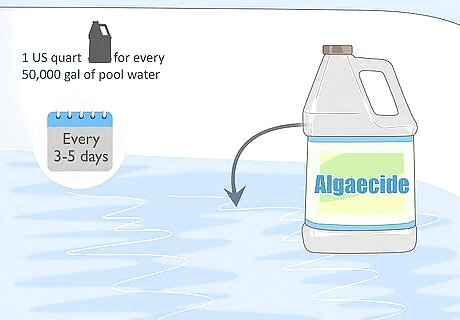
Add an algaecide as a preventative every 3–5 days. Use a maintenance dose of algaecide, which is usually about 1 US quart (0.95 L) for every 50,000 gallons (190,000 L) of pool water. Pour the algaecide into your pool skimmer and let it sit for about 24 hours. After that, vacuum your pool to get rid of any dead algae gathered at the the bottom of your pool. Some algaecides may have different concentrations and usage instructions, so always follow the directions on the package.

Apply a phosphate remover to your pool water. Use a phosphate test kit to check if there are any present in your pool. If the test comes back over 300 ppm, follow the mixing directions of a commercial-strength phosphate remover and pour it into your pool. Run your filter to circulate and get rid of the phosphate remover over the next day or two so the levels go down. After that, shock the pool to restore the chemical balance of your pool. Algae feed off phosphates that get in your pool water from leaves, twigs, or run-off from landscaping, so it’s important to get rid of them.
















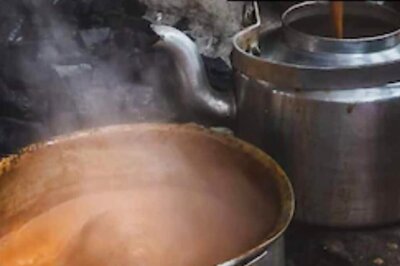



Comments
0 comment